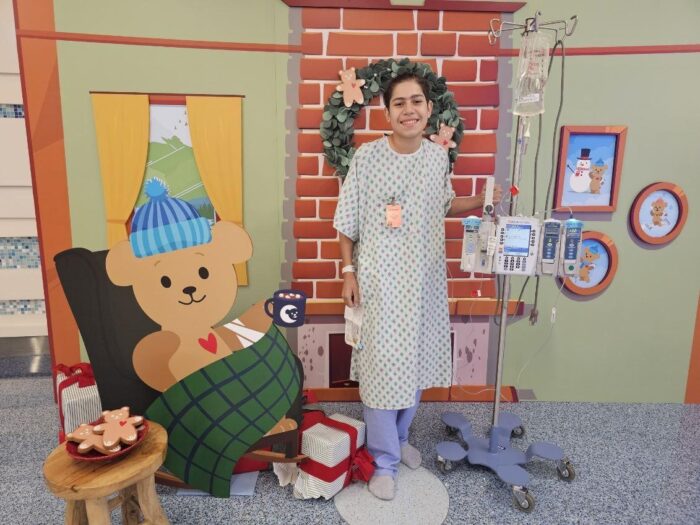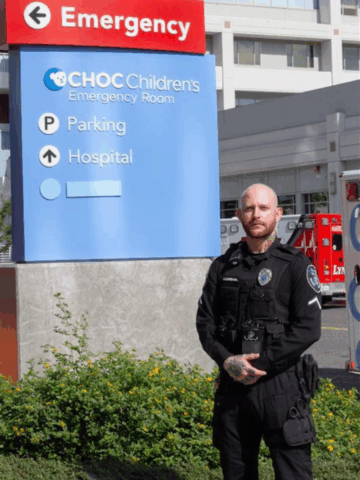Seated at a console 15 feet away from her patient, Dr. Hira Ahmad uses hand controls that look like video game joysticks and foot pedals to control four robotic arms that hover above the teen.
The arms, fitted with tiny surgical tools inserted into marble-sized incisions in the patient’s abdomen, move in real time like a human hand, but with a greater range of motion and with micro precision.
Peering into the console, Dr. Ahmad – a CHOC pediatric general, thoracic and colorectal surgeon – has a 3D view of the surgery area magnified 10 times to what the human eye sees.
In late 2003, CHOC became the first pediatric hospital in California to begin offering robotic-assisted surgery for children.
These days, Dr. Ahmad and her CHOC surgeon colleagues, Dr. Laura Goodman and Dr. Mustafa Kabeer, increasingly are using the da Vinci surgical system for colorectal surgeries, underscoring the growth of the colorectal program two years after Dr. Donald Shaul was recruited to take it to the next level.
“Over the next five years,” Dr. Ahmad says, “we plan to have the biggest and the best colorectal program on the West Coast.”
Landmark surgery
The surgery Dr. Ahmad recently performed was on a 14-year-old patient with Crohn’s disease, a form of inflammatory bowel disease (IBD).
In the four-hour procedure called an ileocecectomy, she removed a chronically inflamed 10-cm section of his appendix, ileum (the last segment of the small intestine) and the cecum (first part of the large intestine), then reconnected the segments.
The surgery marked the first time that a complicated gastrointestinal case has been performed at CHOC from start to finish using the da Vinci surgical system, which also is being used more often in general surgery at CHOC, Dr. Ahmad notes.
The minimally invasive surgery results in smaller incisions and less scarring, a shorter hospital stay and recovery time, and less blood loss and pain than traditional surgery.
And the robotic system gives surgeons like Dr. Ahmad better access and views into the surgery area and the ability to work from an ergonomic station: sitting and wearing only athletic socks to smoothly control the foot pedals.
‘Feeling great’
Jacob Hernandez Gonzalez, the patient whom Dr. Ahmad operated on, has resumed his jiu-jitsu classes and is excited to begin high school this fall and play drums in the marching band.
“I’ve been feeling great,” he says. “They did an excellent job. The surgery went perfectly. I really didn’t feel a thing. I liked how they were all kind to me and always watching me and making sure I was OK.”

Jacob began experiencing pain in his right side just as winter break began that sent him to urgent care, a hospital, and ultimately to CHOC, where he received his IBD diagnosis. He underwent a drain placement with the radiology team after presumably either his appendix or his ileum burst due to infection.
He spent Christmas and New Year’s at CHOC because of complications from this infection.
A perforation in his small intestine made his case complex, and Dr. Ahmad, after consulting with specialists on CHOC’s gastrointestinal and surgical teams, scheduled the surgery. Prior to the operation, Jacob began a “prehab” diet of nutritional supplements and an exercise regimen to aid his recovery.
Dr. Ahmad’s surgical team included Dr. Shaul, a leading expert in treating colorectal disorders, and pediatric surgeon Dr. Troy Reyna.
A unique advantage with the da Vinci is the representative who is present for all the robotic cases for any technical concerns.
Extensive training
In October 2023, Dr. Shaul recruited Dr. Ahmad to CHOC.
A native of the Bay Area who finished high school at age 16, she pursued medicine after shadowing a surgeon she met while working in a kids’ camp after high school.
“This is it,” she recalls thinking. “This is my career.”
After earning her medical degree at Creighton University School of Medicine, Dr. Ahmad completed her general surgery residency at Cleveland Clinic Florida.
She then completed a pediatric colorectal fellowship at Nationwide Children’s Hospital and general pediatric surgery training at Seattle Children’s Hospital. In addition, for two years Dr. Ahmad conducted pediatric colorectal clinical and translational research at Nationwide Children’s.
“I love that the pathology of pediatric colorectal patients is so unique and challenging,” says Dr. Ahmad, who holds an academic appointment at UC Irvine where she engages in clinical research. “With newborn babies, it’s like a riddle; you never know what you will find but you have all the skillsets to solve it.”
CHOC is part of the multi-center collaborative Pediatric Colorectal and Pelvic Learning Consortium, an international group of surgeons, scientists, and other specialists who facilitate research on anorectal malformations, Hirschsprung disease, and other colorectal and pelvic disorders.
CHOC’s colorectal team is hoping to launch a fellowship program in the next few years, Dr. Ahmad says.
Trip of a lifetime
IBD can present at any age and is a lifelong condition that cannot be cured but instead managed by medication.
Crohn’s disease causes inflammation in the digestive tract, which can lead to abdominal pain, severe diarrhea, fatigue, weight loss and malnutrition. It can be both painful and debilitating and sometimes may lead to life-threatening complications.
There’s no known cure for Crohn’s disease, but with treatment, many of those affected can function well.
Every eight weeks, Jacob receives an infusion of a medication, Remicade, meant to keep his symptoms in check.
Prior to his surgery, Jacob and his mother, Denise Gonzalez Hernandez, expressed hope that he would feel well enough to attend with his fellow eighth-graders a spring trip to the East Coast.
His care team at CHOC was able to make sure he was well enough to go.
Jacob went to Boston, New York, Gettysburg in Pennsylvania, and Washington, D.C.
“He had a rock-star view of Times Square from his hotel room,” Denise says.
Jacob says one of the highlights was seeing “MJ The Musical” on Broadway and the monuments of the nation’s capital.
“I was so happy to go and make a lot of memories,” he says.




